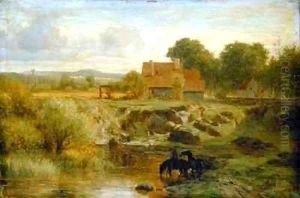Peter Burnitz Paintings
Peter Burnitz was a German artist known for his landscape paintings, born on December 18, 1859, in Frankfurt am Main, Germany. He was part of a generation of artists who were influenced by the changing artistic trends of the late 19th and early 20th centuries, which included Impressionism and the beginnings of Modernism. Burnitz's works often reflect a keen observation of natural light and color, which are characteristic of the Impressionist movement.
Educated in the arts in his hometown, Burnitz later traveled to study in Munich, a city that was, at the time, a vibrant center for artists and intellectuals. His education and exposure to various art circles contributed to his development as a painter. He was particularly influenced by the Barbizon school, a group of French painters who advocated for naturalism and plein-air painting. This influence is evident in Burnitz’s works, where he frequently depicted the German countryside and rural scenes with a focus on the effects of light and atmosphere.
During his career, Peter Burnitz exhibited his works at various art shows and became a respected figure among his peers. His paintings were appreciated for their serene beauty and his ability to capture the mood of a landscape. Despite his success, Burnitz kept a relatively low profile and did not seek the same level of fame or notoriety as some of his contemporaries.
Peter Burnitz's contributions to German art were cut short by his death on October 21, 1929. His legacy is preserved in the collections of German museums and in the esteem of art historians who recognize his talent for landscape painting. Though not as widely known as some of his Impressionist counterparts, Burnitz's work remains a testament to the rich artistic culture of his time and his personal vision of the natural world.
